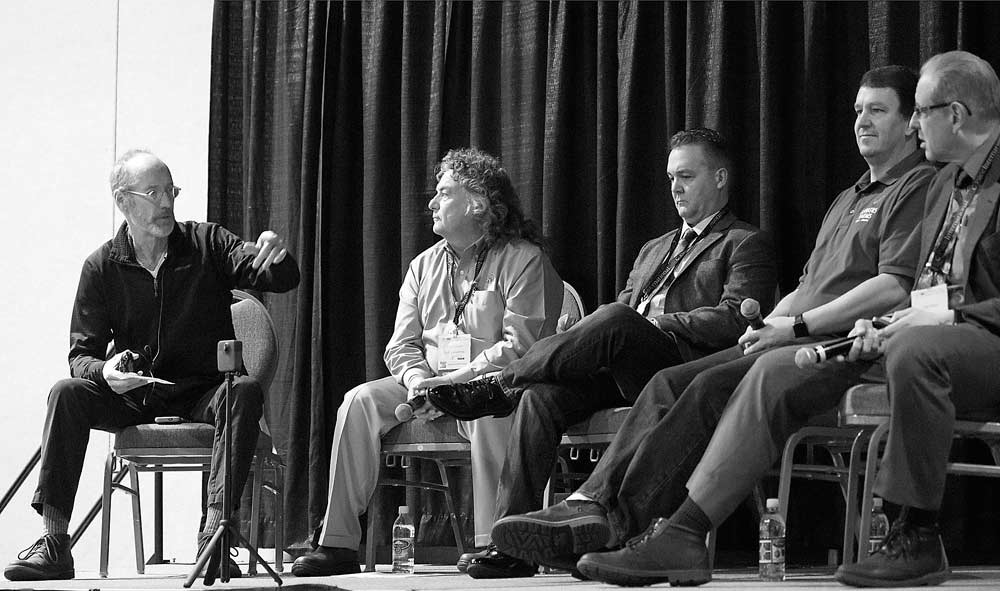
The H2-A panel on the final day of the 113th Annual Meeting and NW Hort Expo in Kennewick, Washington, on December 6, 2017. (TJ Mullinax/Good Fruit Grower)
The Washington State Tree Fruit Association annual meeting wrapped up Wednesday with two sessions on pests, diseases and soils and on labor and labor-saving technologies.
The labor session included two panels addressing key issues of interest to growers: the federal H-2A guest worker program and development of robot-ready canopies.
H-2A workers today comprise about 20 percent of Washington’s agricultural workforce. Washington had 18,535 H-2A visas approved this year, up from about 13,700 last year, according to Dan Fazio of Wafla, a Lacey, Washington, nonprofit agricultural contractor. Those are sharp increases from the roughly 9,000 visas approved in 2014.
Cost is the biggest driver, Fazio said, and the biggest cost is housing — estimated at about $10,000 to build one bed. More investors are constructing facilities that would enable growers to potentially rent beds, allowing growers to pass on being landlords, Fazio said. The charge is about $250 per month to rent a bed or about $3,000 per bed per year.
The panel offered several tips for making the program more affordable:
• If a grower has a short season, he or she could look for another grower to send the workers to before or after the period in which they’re needed, which reduces the per worker fee by 40 percent or more. In addition, look for additional tasks that could be added to extend the season.
• Keeping H-2A workers for six month offers a tax benefit of between 10 percent and 12 percent in Washington, with savings on Social Security and Medicare taxes and state unemployment insurance.
• Placing several operations on one contract reduces costs and provides a backstop – workers can work for any employer listed in the contract. And having several operations reduces risk, but Fazio noted, “You’re only as strong as your weakest link.”
Another panel offered insights into how growers can prepare orchard canopies for automatic harvesters. A look at several orchards where the machine under development by Abundant Robotics worked last year showed one orchard had a high of 86 percent of the fruit being accessible. The numbers fell from there.
Abundant CEO Dan Steere noted the biggest hindrances to an apple being “seen” by the harvester are if the fruit is clustered or if there is wood or a wire blocking it.
That posed some challenges in a V-trellis, said Dave Allan of Allan Brothers, one of the companies working with Abundant to test the machine in development.
A vertically trellised orchard had 71 percent of its fruit accessible, but an angled V-trellis orchard had only 68 percent of the fruit accessible. “On an angled canopy, we’re going to have to have darts downward and outward into the row,” he said.
After a tough year for fireblight in the Northwest, an advice presentation about how to fight it played to a packed meeting hall during the pest and disease session Wednesday, the final day of the Washington State Tree Fruit Association annual meeting in Kennewick.
Ken Johnson of Oregon State University and Drew Hubbard at G.S. Long told growers to avoid watering apple and pear trees during bloom, cut away infected areas quickly and cleanly and keep a close eye on the temperatures, among other tips.
Generally speaking, Pacific Northwest growers reported high pressure from fireblight in 2017.
Johnson advised aggressive measures, especially on young vigorous trees, to keep the bacterial infection in check. For example, he suggested growers cut two to four feet below cankers, well beyond visible symptoms to get ahead of the bacteria toward the trunk. For trees in their first or second year, they should just consider ripping out the tree altogether.
Also, growers should consider removing all flowers on young trees by hand during during bloom, as well as extending their control programs a week past petal fall. Trees are most susceptible to fireblight during bloom, especially in damp conditions.
Hubbard suggested saving strep, one of the stronger antibiotics, for bad infections, as well as mixing antibiotics with Actigard.
Other topics in the pest and disease session were apple maggot detection, efforts to trap the Spotted Wing drosophila, the spread of Brown Marmorated Stink Bug, fighting Little Cherry Disease and managing water stress.
Time constraints limited questions Wednesday but session managers promised to post extra questions, with answers, on the Tree Fruit Association website.






Leave A Comment